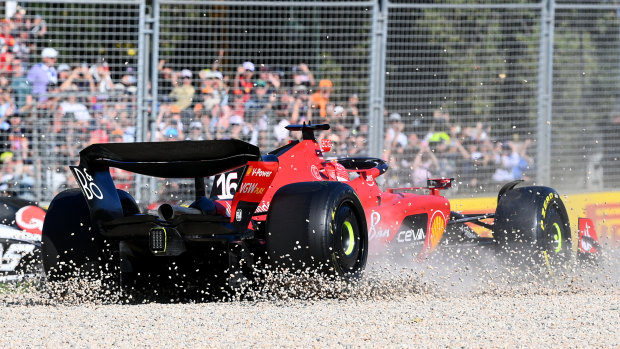
While drivers typically are cautious at standing starts early in races, Nicic said the prospect of a three-lap sprint at the end meant drivers were ready to take greater risks.
“The critical nature of a three-lap standing start is extreme,” Nicic said. “The reward is high for the drivers, the risk is the carnage that we observed.”
Westacott agreed. “It was about 12 cars left in the race at the end. When that happens, getting out there for two laps – or what could’ve been a one lapper at the end – is gonna mean they’re going hammer and tongs,” he said.

Ferrari’s Charles Leclerc gets stuckin a gravel trap at the grand prix.Credit:Getty Images
In 2022, the Albert Park track was streamlined to make for faster racing. Seven corners were widened, and a lakeside chicane removed altogether, increasing minimum and maximum speeds, reducing lap times by more than five seconds and opening up more chances for overtaking.
But most of the crashes were at the first three turns, shortly beyond the starting grid, where the field is bunched up for the start and after red flag delays.
Westacott believed that the high incidence of crashes was a one-off, and not the fault of the track changes.
“I’ve got no doubt the speed of the circuit, particularly around lakeside, has led to more fierce racing, and probably has led to an increase in some of the overtaking, and definitely the spectacle,” he said.
He added that the new F1 cars, introduced in 2022, were also faster: “Formula 1 improves things, inherently, as things go along,” he said. “So over a whole season - and in aerodynamics in the off season - the cars are quicker.”
Nicic said the time of day and weather added to the hazards facing the drivers, but wasn’t the main cause of the crashes.
Sunday was the first day after daylight saving finished in Victoria and the sun was setting at the time of the standing start.
It was enough of a problem that Red Bull’s Sergio Perez said the race needed to start earlier to avoid blinding the drivers. “The sun is basically in our face – at the restart we couldn’t see anything,” Perez said.

Max Verstappen takes the chequered flag as the sun sinks at the Grand Prix on Sunday.Credit:Getty
Approaching sunset, the track also cools. Some drivers describe dusk as “happy hour” - the setting sun cools the track to the 25-30 degrees, which improves the traction of the tyres.
“The grip improves because if the track surface is too hot - let’s say above 40 degrees - tyres can really squirm,” Nicic said.
“[Dusk] is usually a really good time for the grid. But what it can do is promote tyre life, and so you get drivers being a little more courageous and overpredict the benefits of what they’re going to achieve.”
Nicic said the sun would have been in the drivers’ eyes on lap 56, immediately after the re-start, as they braked into turns 1 and 2. “It would impact any driver’s ability, regardless of their expertise,” he said.
Wind changes, causing leaf debris on the track, and too much cooling (which can form a grit on the surface) could also have had an impact, he said.









 Add Category
Add Category